
Kinabatangan River: Uncle Tan's Wildlife Camp
From Poring we flagged down a bus to take us to Sandakan . On the outskirts of town is a hostel called “Uncle Tan's” that has a jungle camp on the Kinabatangan river. While the upper part of the river has been completely logged, there is still a patchwork of forests and protected areas along the middle part. One of the main reasons why the Kinabatangan river is so good for wildlife viewing is that only a thin strip of forest remains on either side. The animals are concentrated and easily spotted. We could see this for ourselves as we set out by boat for the camp in the afternoon. Right away we spotted three species of hornbill, a fishing eagle and groups of proboscis monkeys.
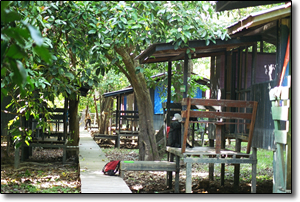 |
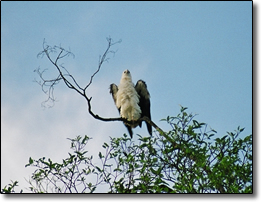 |
Uncle Tan's Wildlife Camp is situated on an oxbow lake near the river. Conditions in the camp are very basic. There are small huts for sleeping, with mattresses on the floor, mosquito nets to keep out the bugs and screens to keep out the monkeys. The shared composing toilets are simple. Water for washing and bathing, taken directly from the river, is still muddy. Electricity runs a few hours every night. The camp runs a full schedule. At 6am comes a wake-up call for the morning boat tour. After a quick cup of coffee, boats go out onto the river for wildlife viewing. After breakfast, there is a short walk in the jungle. After lunch, when the heat is the worst, there are a few hours of leisure time. At 4pm is another boat tour for afternoon wildlife spotting, then after dinner is a night walk or boat ride. With the exhausting tropical heat, it is quite a challenge to do everything.
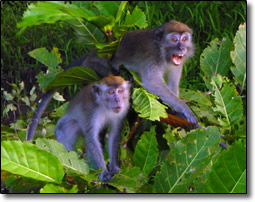 |
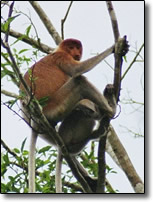 |
The morning and afternoon boat rides were the best way to see proboscis monkeys. There were also silver leafed langurs, rare red langurs, pig-tailed macaques and the ubiquitous long-tailed macaques. It was possible to see six species of monkeys (including orangutans) in one day. Once, at dusk, we saw a civet cat prowling high in a tree. Hornbills were easy to spot flying overhead, or in the treetops. Perched on the branches, low along the river, were often brightly colored kingfishers or flycatchers. Higher up, at the top of the tallest trees, were occasionally sea eagles or kites.
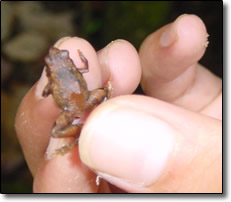 |
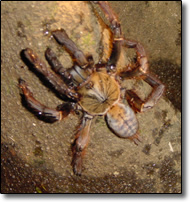 |
Even in camp there were plenty of animals. In the nearby trees lived a giant Borneo squirrel and a tiny pygmy squirrel. Not far from the camp headquarters could be found the lesser narrow mouth frog, the world's smallest. Guides pointed out bats sleeping in rolled-up leaves and millipedes that smelled like almonds when squeezed. No jungle camp is complete without its scavengers: monitor lizards, a bearded pig and those pesky macaques. By early morning they were already on the prowl, looking for unlocked cabin windows and doors. The bravest would hover around the kitchen, looking for an opportunity to grab leftover food.
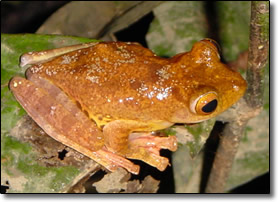 |
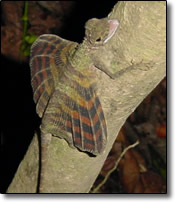 |
Night walks are the best way to see smaller animals close at hand. We learned how to hold our spotlights at eye level and scan for eyes in the forest. A green, twinkling reflection was a spider. A red reflection was a frog or mammal. The lead guide was a frog freak. His led us through knee-deep water and muck in the nearby swamps in search of amphibians. One night we saw 10 species of frog in one hour! The guide also pointed out insects. A hairy centipede sitting on a tree trunk ran with incredible speed when disturbed. High on another tree trunk sat two nasty-looking, barbed centipedes. “You don't want to get bit by one of those!” I spotted a tarantula and our guide rushed over, sent for his camera, and spent the rest of time taking pictures of the spider in different positions. He was compiling a book on the Kinabatangan river and had not seen any tarantulas yet. Later, he found a flying lizard on a branch. Taking it by the neck, he carefully opened its “wings” to show us. After our night excursions, the camp staff would pick up their guitars, play and chat with the guests.
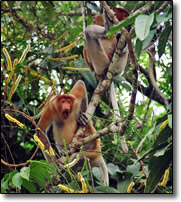 |
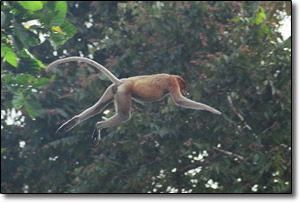 |
One night, as we were sleeping, I reached up above my head to adjust my pillow. Suddenly, I felt a stinging sensation in my finger. Groggy, I reached for the light. It sure hurt - what could it be? My finger was pounding. I shone the light around the head of the bed and saw a nasty-looking centipede with a big pair of jaws. It was the same kind as the one that the head guide had pointed out earlier. Making sure it did not climb into bed, I woke Anne and chased the beast into a corner, where I whacked it flat and dead. I was worried about the effects of the poison, though. The head guide had reported how his hand swelled up like a ski glove when one bit him. Worried, I took an antihistamine and an ibuprofen, and tried to get back to sleep. I felt strange and woozy.
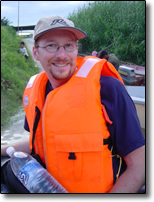 |
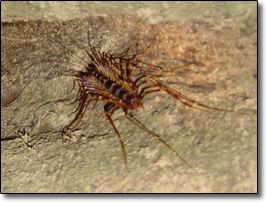 |
When I closed my eyes, I could see shifting, colored patterns in the dark. Was it the venom or was I just frightened? I tried to ignore the pain, and eventually managed to get some sleep. In the morning my hand was only slightly swollen and the pain, except for a dull ache, was gone.
After four days of Uncle Tan's, it was time to leave. Our last stop in Sabah was Tawau, near the Indonesian border. After visiting the large fish market in town, we got a ride to the airport and took a flight back to Kuala Lumpur.
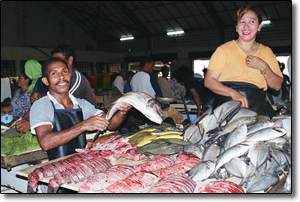 |
 |
